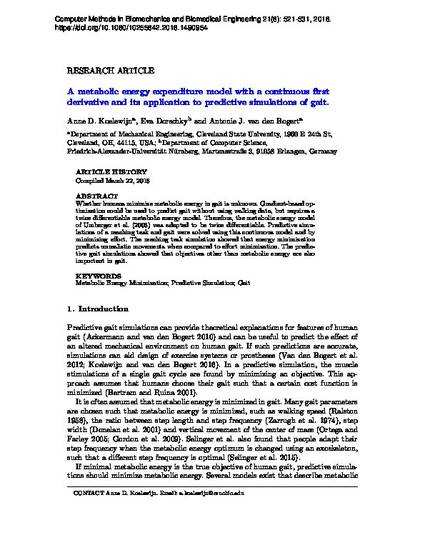
Article
A Metabolic Energy Expenditure Model with a Continuous First Derivative and its Application to Predictive Simulations of Gait
Computer Methods in Biomechanics and Biomedical Engineering
(2018)
Abstract
Whether humans minimize metabolic energy in gait is unknown. Gradient-based optimization could be used to predict gait without using walking data, but requires a twice di
erentiable metabolic energy model. Therefore, the metabolic energy model of Umberger et al. (2003) was adapted to be twice di
fferentiable. Predictive simulations of a reaching task and gait were solved using this continuous model and by minimizing e
ffort. The reaching task simulation showed that energy minimization predicts unrealistic movements when compared to e
ffort minimization. The predictive gait simulations showed that objectives other than metabolic energy are also
important in gait.
Keywords
- Metabolic energy,
- Predictive simulation,
- Gait
Disciplines
Publication Date
July 20, 2018
DOI
10.1080/10255842.2018.1490954
Publisher Statement
“This is an Accepted Manuscript of an article published by Taylor & Francis Group in Computer Methods in Biomechanics and Biomedical Engineering on 7/20/2019, available online: https://www.tandfonline.com/doi/abs/10.1080/10255842.2018.1490954?journalCode=gcmb20
Citation Information
Anne D. Koelewijn, Eva Dorschky and Antonie J. van den Bogert. "A Metabolic Energy Expenditure Model with a Continuous First Derivative and its Application to Predictive Simulations of Gait" Computer Methods in Biomechanics and Biomedical Engineering Vol. 21 Iss. 8 (2018) p. 521 - 531 Available at: http://works.bepress.com/antonie_vandenbogert/92/
